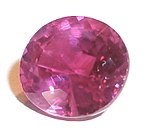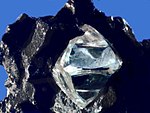Mohs scale of mineral hardness
The Mohs scale of mineral hardness is a qualitative ordinal scale which characterizes the scratch resistance of various minerals through the ability of a harder material to scratch a softer material. It was created in 1812 by the German geologist and mineralogistFriedrich Mohs and is one of several definitions of hardness in materials science, some of which are more quantitative.The method of comparing hardness by seeing which minerals can visibly scratch others, however, is of great antiquity, having been mentioned by Theophrastus in his treatise On Stones, c. 300 BC, followed by Pliny the Elder in his Naturalis Historia, c. 77 AD.While greatly facilitating the identification of minerals in the field, the Mohs scale is not suitable for accurately gauging the hardness of industrial materials.
Minerals
The Mohs scale of mineral hardness is based on the ability of one natural sample of mineral to scratch another mineral visibly. The samples of matter used by Mohs are all different minerals. Minerals are pure substances found in nature. Rocks are made up of one or more minerals.[6] As the hardest known naturally occurring substance when the scale was designed, diamonds are at the top of the scale. The hardness of a material is measured against the scale by finding the hardest material that the given material can scratch, and/or the softest material that can scratch the given material. For example, if some material is scratched by apatite but not by fluorite, its hardness on the Mohs scale would fall between 4 and 5.[7] "Scratching" a material for the purposes of the Mohs scale means creating non-elastic dislocations visible to the naked eye. Frequently, materials that are lower on the Mohs scale can create microscopic, non-elastic dislocations upon materials that have a higher Mohs number. While these microscopic dislocations are permanent and sometimes detrimental to the harder material's structural integrity, they are not considered "scratches" for the determination of a Mohs scale number.[8]
The Mohs scale is a purely ordinal scale. For example, corundum (9) is twice as hard as topaz (8), but diamond (10) is four times as hard as corundum. The table below shows comparison with absolute hardness measured by a sclerometer, with pictorial examples.[9][10]
| Mohs hardness | Mineral | Chemical formula | Absolute hardness[11] | Image |
|---|---|---|---|---|
| 1 | Talc | Mg3Si4O10(OH)2 | 1 |  |
| 2 | Gypsum | CaSO4·2H2O | 3 |  |
| 3 | Calcite | CaCO3 | 9 |  |
| 4 | Fluorite | CaF2 | 21 |  |
| 5 | Apatite | Ca5(PO4)3(OH−,Cl−,F−) | 48 |  |
| 6 | Orthoclase | KAlSi3O8 | 72 |  |
| 7 | Quartz | SiO2 | 100 |  |
| 8 | Topaz | Al2SiO4(OH−,F−)2 | 200 |  |
| 9 | Corundum | Al2O3 | 400 |  |
| 10 | Diamond | C | 1600 |  |
On the Mohs scale, a streak plate (unglazed porcelain) has a hardness of 7.0. Using these ordinary materials of known hardness can be a simple way to approximate the position of a mineral on the scale
Intermediate hardness
The table below incorporates additional substances that may fall between levels:
Hardness (Vickers)
Comparison between Hardness (Mohs) and Hardness (Vickers):
| Mineral name | Hardness (Mohs) | Hardness (Vickers) kg/mm2 |
|---|---|---|
| Graphite | 1–2 | VHN10=7–11 |
| Tin | 1½ | VHN10=7–9 |
| Bismuth | 2–2½ | VHN100=16–18 |
| Gold | 2½ | VHN10=30–34 |
| Silver | 2½ | VHN100=61–65 |
| Chalcocite | 2½–3 | VHN100=84–87 |
| Copper | 2½–3 | VHN100=77–99 |
| Galena | 2½ | VHN100=79–104 |
| Sphalerite | 3½–4 | VHN100=208–224 |
| Heazlewoodite | 4 | VHN100=230–254 |
| Carrollite | 4½–5½ | VHN100=507–586 |
| Goethite | 5–5½ | VHN100=667 |
| Hematite | 5–6 | VHN100=1,000–1,100 |
| Chromite | 5½ | VHN100=1,278–1,456 |
| Anatase | 5½–6 | VHN100=616–698 |
| Rutile | 6–6½ | VHN100=894–974 |
| Pyrite | 6–6½ | VHN100=1,505–1,520 |
| Bowieite | 7 | VHN100=858–1,288 |
| Euclase | 7½ | VHN100=1,310 |
| Chromium | 8½ | VHN100=1,875–2,000 |

No comments:
Post a Comment